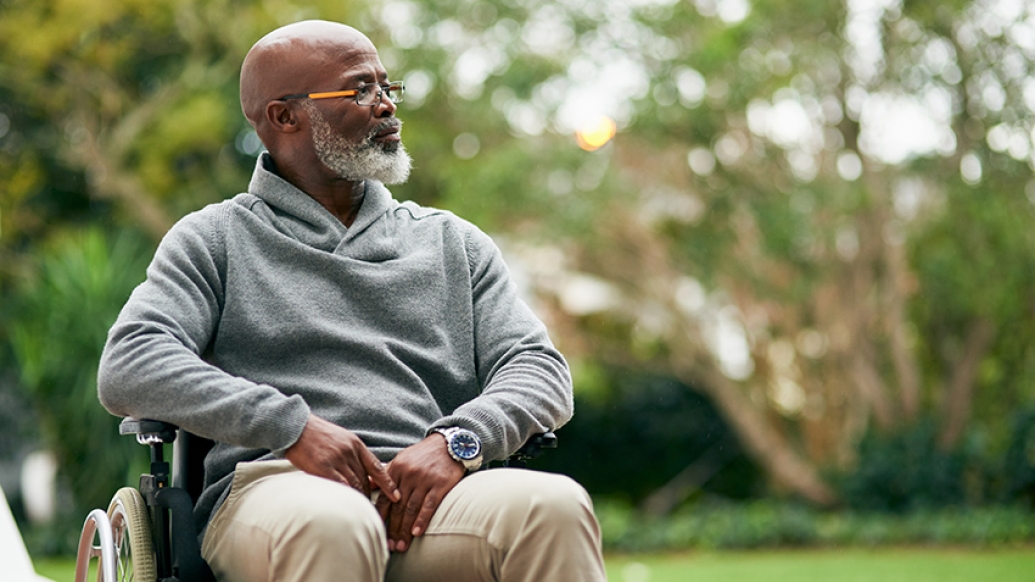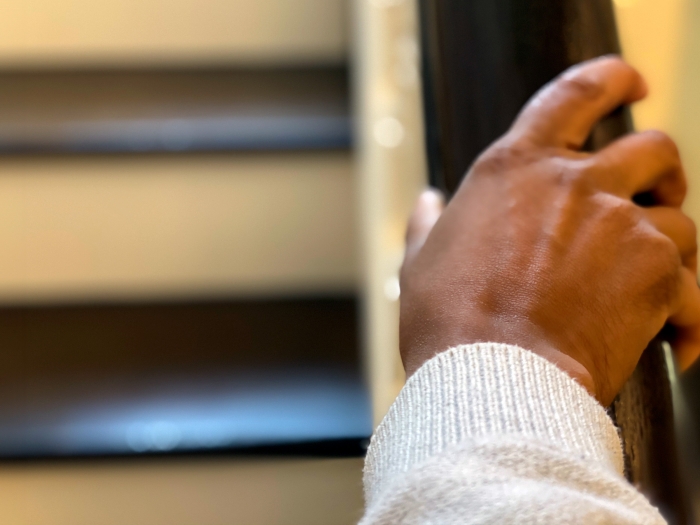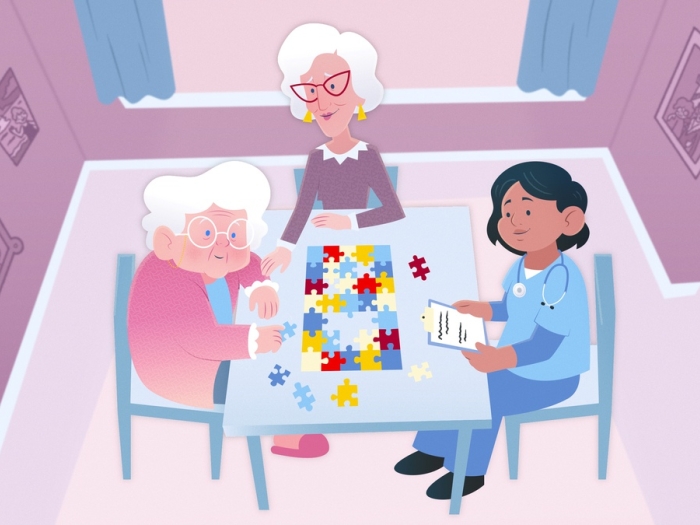A $4.3 million grant will help establish a Rehabilitation Research and Training Center at the U-M and Michigan Medicine. Learn more about the collaborative effort.
1:16 PM
Author |

Nationally, 1 in 5 adults lives with a disability.
But knowing what it's like for those 53 million people to age — and how their unique needs may change over time — isn't always clear to the professionals that provide care.
LISTEN UP: Add the new Michigan Medicine News Break to your Alexa-enabled device, or subscribe to our daily audio updates on iTunes, Google Play and Stitcher.
"When we work in a health care system, we interact with patients with disabilities, but we don't always understand what it's like to live with a physical disability," says Michelle Meade, Ph.D., associate professor of physical medicine and rehabilitation at Michigan Medicine and a member of the Institute for Healthcare Policy and Innovation.
"For example, managing other health conditions, such as diabetes or the aftereffects of a stroke, while dealing with a spinal cord injury or cerebral palsy adds another level of complexity."
That complexity is what led Meade to seek funding from the National Institute on Disability, Independent Living and Rehabilitation Research (NIDILRR) to establish a Rehabilitation Research and Training Center (RRTC) program at U-M.
RRTC programs conduct research, offer training and disseminate information around rehabilitation topic areas determined by the NIDILRR. There are 23 active programs operating across the United States.
Supported by $4.3 million in NIDILRR funding over the next five years, the U-M RRTC will generate research around the interactions between personal and environmental factors associated with better health outcomes for people with physical disabilities.
Known as the Investigating Disability Factors and Promoting Environmental Access for Healthy Living RRTC — or IDEAL, for short — the U-M center will also use the research it generates to develop evidence-based interventions to help this patient population live better.
"People think that people living with physical disabilities should have a low quality of life because they have a disability," says Meade. "But there are many things that can be done to ensure positive outcomes and prove that people can live meaningful lives with physical disabilities."
Meade serves as director of the center and is joined by co-principal investigators Philippa Clarke, Ph.D., professor of epidemiology at the University of Michigan School of Public Health and research professor at the U-M Institute for Social Research, and Robyn Rontal, J.D., MHSA, policy analytics director for the Center for Healthcare Research and Transformation in Ann Arbor.
Goals and research plans
The IDEAL RRTC has four main objectives:
-
Identify environmental factors, including the practices, programs and policies, that are associated with healthy aging for individuals with long-term physical disabilities from diverse backgrounds — particularly those from low-income and racial/ethnic minority communities.
-
Develop interventions to modify environmental factors to enhance the health, functioning and participation of individuals aging with long-term physical disabilities.
-
Serve as a national resource center to improve outcomes for people aging with long-term physical disabilities, their families and other stakeholders by providing information, training and technical assistance to a variety of groups — including individuals with disabilities, disability and rehabilitation researchers, clinicians and service providers, and policymakers.
-
Engage key stakeholder groups, particularly disability- and aging-related organizations, to bridge programs and practices for older adults and people with disabilities and maximize the relevance and usability of the new knowledge generated by the RRTC.
Taking stock of environmental factors associated with good health is a key objective.
Says Meade: "An individual with a physical disability living in an area with accessible buses, good health care and government policies that promote accessibility to resources may have more opportunities than an individual living in an environment with low resources and health care over an hour away."
MORE FROM THE LAB: Subscribe to our weekly newsletter
Which is why the research portion of the center's work will be critical.
"We're going to examine and identify key gaps in existing literature and, using national insurance claims databases, look at the trajectories for existing individuals," Meade says. "We'll look at factors such as gender, age, hospitalizations, geography, current health care policies and so on."
Next, the center will conduct participatory research.
"We'll then reach out and do community-based participatory research collaborating with physical disability organizations in the Flint and Detroit communities, looking for individuals who have been thriving and those who have not, and talking with them about their challenges and what has helped them most," Meade says. "Pairing this information with the information from the claims databases will help us map between environmental factors and what makes positive outcomes."
The center will then take these knowledge discoveries to create interventions.
"One example is our family medicine team is going to then look at this data and explore how we could set up a clinic to be most responsive for this group of individuals," Meade says.
Another example: Clive D'Souza, Ph.D., an assistant professor of industrial and operations engineering at U-M, and a co-investigator and project director in the center, will focus on transportation access and aim to inform the deployment of autonomous vehicles for individuals with physical disabilities.
Says Meade: "The center is truly leveraging what's best about U-M: partnering with our colleagues and communities to make a difference."
The center will act as a national resource center for stakeholders, policymakers and disability organizations.
"For example, how do we make sure health care providers in rural Nebraska have the information they need to make the appropriate treatment and projections for their patients with physical disabilities," Meade says. "The center will create a resource for them to turn to for more information."
Growth potential
The IDEAL RRTC will launch in October with their website; research projects are set to begin within the following six months.
SEE ALSO: Rich Seniors Are Getting Healthier, Leaving the Poor Behind
"After the first year, we hope to begin publishing results from some of the studies," Meade says. "The rollout plan for the center allows us to have projects going on with two or three studies within each project.
"A key piece will be how we present our findings so that people can understand and use it — especially the policy briefs that will be developed by Ms. Rontal and the team at the Center for Healthcare Research and Transformation to highlight the connections between state and national policies and health outcomes."
The IDEAL RRTC is led by center director Michelle Meade, Ph.D. She is joined by co-principal investigators Philippa Clarke, Ph.D., and Robyn Rontal, J.D., MHSA. Co-investigators for the center include Clive D'Souza, Ph.D.; Elham Mahmoudi, Ph.D.; Michael McKee, M.D., MPH; Shan Parker, Ph.D.; Mark Peterson, Ph.D.; Amy Pienta, Ph.D.; Melissa Riba, M.A.; and Rie Suzuki, Ph.D.

Explore a variety of healthcare news & stories by visiting the Health Lab home page for more articles.

Department of Communication at Michigan Medicine
Want top health & research news weekly? Sign up for Health Lab’s newsletters today!





